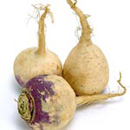Rooting for Rutabagas
 Today, Sara Cabot of Little Lettice makes a case for the humble rutabaga:
Today, Sara Cabot of Little Lettice makes a case for the humble rutabaga:
“Rutabagas are in season, and as you skim by the pile of these humble root vegetables in your grocery store’s produce section, you may be curious to learn more about this lesser-eaten vegetable, which is known as a ‘swede’ in England due to its popularity in Scandinavian countries.
A rutabaga is a cross between a cabbage and a turnip. Rich in beta-carotene (vitamin A), the rutabaga has a delicate sweetness that makes it a good vegetable for the whole family to enjoy. It’s also an inexpensive vegetable and is easy to find both organic and local.
Rutabagas for Babies
As a root veggie, rutabagas are one of the first veggies you can give your baby when you’ve been through the apples, pears, sweet potato, and squash routine. Move right on to the rutabaga (parsnips and turnips can also be treated in the same way); babies will love rutabagas due to their sweet flavor.
To prepare: wash, peel, and cut rutabagas into 1” cubes and then boil in water until tender (don’t overdo). Drain and puree in a Cuisinart, and serve slightly warm. Freeze leftovers in small containers or ice cube trays.
Mixers: Rutabaga is delicious pureed with any of these veggies in any combination: parsnips, carrots, turnips, butternut squash, potatoes.
Rutabaga for Toddlers & Grownups
In England, ‘mashed swede’ (i.e., mashed rutabaga) is a traditional Sunday lunch favorite along with roast potatoes and leeks in a cream sauce.
To prepare mashed swede: Simply treat the rutabaga like a potato; peel and cut into cubes, boil and drain, then mash with butter, salt, and pepper to taste.
To prepare roasted rutabaga: my friend Alice Waters has great advice for roasted root veggies:
1. Preheat oven to 400 degrees. Cut vegetables (try rutabaga with butternut squash, parsnip, potatoes, or celery root), keeping size uniform, around 1” cube.
2. First mix vegetables in olive oil so that the oil clings to the veggies, then add herbs such as rosemary & thyme, and ensure even distribution.
3. Place vegetables in a baking dish and place in oven. While the veggies should get browned and slightly caramelized, stir occasionally to prevent them from getting too crisp and dried out.”
Image credit: UMass Amherst Vegetable Program
